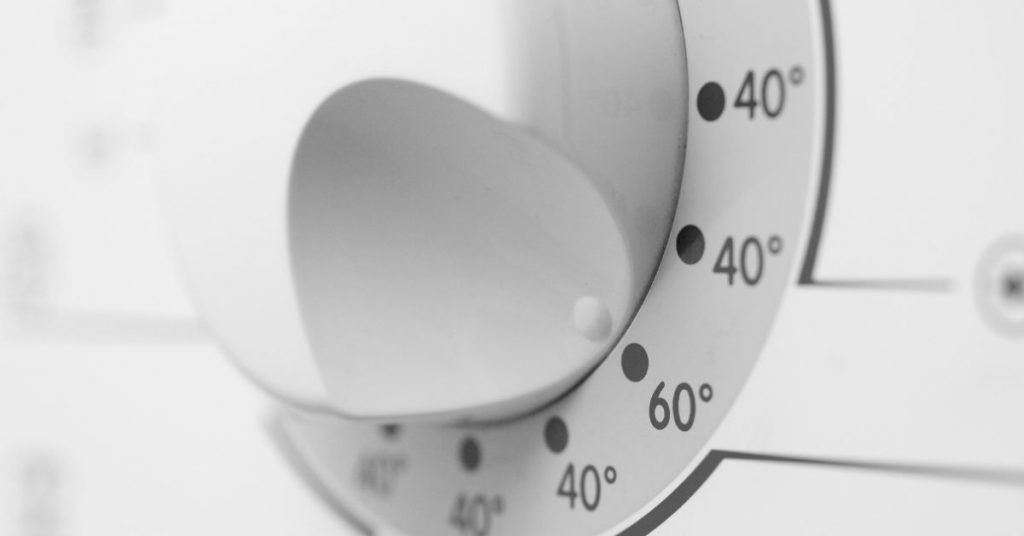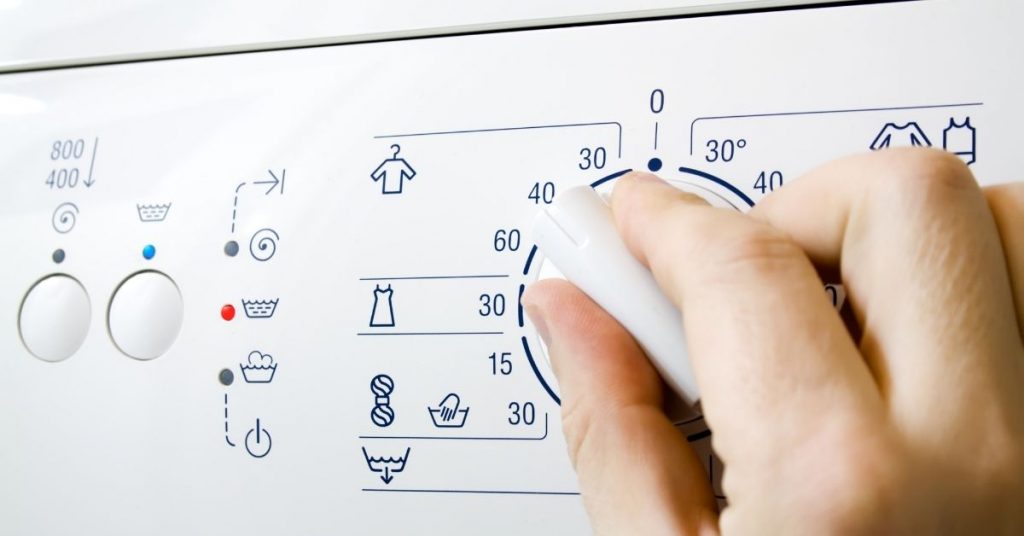A guide to Washing Machine Temperatures and When to Use Them
Most laundry products are constantly improving their formulas so we can reduce the temperature of our wash cycles.
These lower temperatures can reduce wash times, help the environment, prolong the life of our clothes and also reduce our bills.
Due to current global circumstances, it’s definitely worth being more cautious will how well our clothes are actually being cleaned.
But don’t worry, we aren’t trying to suggest we should all boil our clothes and linens to destroy all traces of germs.
There are certain items that will naturally become more soiled than others, which do require a more thorough clean.
We’ve put together this washing machine temperature guide to help clear-up which items should be washed at which temperatures.
This post will also cover some top laundry FAQ’s including:
- What Temperature to Wash Towels
- What Temperature to Wash Bedding
- What Temperature to Wash Whites
Washing Machine Temperature Guide
The following advice is generalised to suit most clothing items, but you should always check the labels of individual items to find out what temperatures they can be washed at.
Washing at 20
Since 2013 all washing machines in the UK are required to have an ecological cool setting of 20 degrees celsius.
This cooler setting decreases running costs due to the smaller amount of energy required to run it.
According to Which, “Using 20°C instead of 40°C could reduce running costs by 62%”.
However, this cheaper cycle compromises on the quality of laundering.
It’s great for washing delicate items like silk or under-wired clothing, but will likely leave grease and dirt inside our clothes.
| What to wash at 20: A cold wash should be used when refreshing already clean items, or when washing delicate items like silk fabrics or clothing with wire, like bras and corsets. |
This setting will also encourage mould and scum to build up inside a washing machine.
If a bad smell starts to form in the washing machine, you can use a bleach-based or mould removing cleaning product to clean inside the machine and the rubber seal.
Alternatively, check out our Clean and Tidy Living articles where we recommend cleaning washing machines with white vinegar, or with white vinegar and baking soda.
Pros
Cons
Washing at 30
Due to the improvements in detergents over the years, 30-degree washes can handle most stains and dirt.
Although they will generally clean clothes very well, the warm temperature might not properly sanitize fabrics.
We, therefore, don’t suggest washing underwear, towels and bedding at 30 as these tend to be dirtier and contain more dangerous bacteria than other items.
The running costs of a warm wash are slightly higher than a 20-degree wash but still much lower than 40 or 60-degree hot washes.
| What to wash at 30: 30 degrees is ideal for items like wool and silk when set to a delicate or hand wash cycle, as long as it’s longer than any quick setting. Washing colours at 30 is also recommended by detergent companies such as Ariel. |
Ariel also suggests that the following items should be washed on 30 degrees:
- Colours
- Blouses
- Acrylics
- Sportswear
- Light summer clothing
- Acetate
- Shirts
- T-shirts
- Wool
Is 30 degrees a cold wash?
30 degrees is in between a warm and cold wash, but depending on the water source, 30 in the winter might be closer to 20 degrees so should be treated as a cold wash.
Pros
Cons
Washing at 40
Washing at 40 degrees with a laundry detergent that kills bacteria, like a bleach-based detergent, will sanitise clothing as effectively as washing at 60.
We, therefore, think that washing at 40 degrees is the best setting for the majority of items when it comes to killing viruses, germs and bacteria.
However, it’s not recommended to use this hotter temperature to wash delicates or colours as it can fade, shrink or damage clothing.
A 40-degree wash will have slightly higher running costs than a 30-degree wash.
| What to wash at 40: Underwear, bedding and towels should be washed at 40 degrees with a bleach-based detergent to properly clean and sanitise these items. When washing coloured clothing, use a colour-safe detergent to prevent the hot temperature from fading clothes. |
Ariel suggests washing the following items at 40 degrees:
- Bed linen
- White cotton fabrics
- Viscose
- Wool or Synthetics
- Wool/Polyester blends
- Towels
- Underwear
Pros
Cons
Washing at 60
In our article What Temperature Kills Bacteria In A Washing Machine we recommend that the optimum temperature for killing bacteria, viruses and germs is 60 degrees.

However, washing at 60 alone isn’t enough to kill bacteria and we should use a bleach-based laundry detergent alongside hot temperatures for optimum sanitising.
| What to wash at 60: Towels, white cotton, bedding and underwear can be washed at 60 with great results. Washing other clothing items at 60 will kill bacteria and sanitise very well but may damage, shrink or fade items so wash with care. |
But of course, this high temperature takes a lot of energy to heat up and keep hot for the entire cycle.
Some experts suggest that there isn’t much difference between washing at 40 with a good detergent and washing at 60.
Hot temperatures like 60 degrees Celsius will also clean the washing machine quite well and stop mould and bacteria from multiplying in the drum.
Pros
Cons
Washing at 90
The 90-degree setting should always be used with caution, as this hot cycle can damage and fade clothing beyond repair.
We suggest only using this setting when:
- Killing insect infestations
- Brightening white fabrics like cotton sheets
- Removing very stubborn stains or cleaning very soiled items
- Cleaning the washing machine on a maintenance cycle
| What to wash at 90: this very hot wash should be used rarely, and only when completely necessary in the following situations: killing bugs, brightening white cotton, removing very stubborn stains or cleaning the washing machine. |
However, even in these situations the hot water can still cause shrinkage or damage to fabrics and should be very rarely used.
Another downside to the 90-degree wash is the high running costs and poor environmental efficiency.
We recommend attempting to clean items at 60 degrees before jumping to the 90-degree wash, to avoid any damage or colour fading to the items.
Pros
Cons

Laundry & Washing Machine Temperature Guide FAQs
Washing towels at a minimum of 40 degrees and a maximum of 60 degrees will ensure they are properly sanitised when using a bleach-based laundry detergent.
After the wash cycle has finished, remove the towels as soon as possible from the washing machine to prevent bacteria and germs from multiplying inside the fibres.
Ensure towels are completely dry before folding them away to avoid mould and damp smells from emerging.
According to the NHS, bedding should be washed once a week at 60 degrees to kill bacteria and remove the buildup of dirt and dead skin cells.
Be sure to use good bleach-based laundry detergent for maximum results when cleaning bedding.
White cotton is ideal to use as bedsheets as it can be washed at very high temperatures without fading or deteriorating.
Colours tend to fade when washed at hotter temperatures. Luckily, whites can be washed at very high temperatures with no visible damage or wear.
Whites should be washed at 30-40 degrees for light-medium soiled clothing, but 40-60 for bedding, towels and underwear.
Always check the labels as some fabrics will shrink at warmer temperatures.
General day-to-day washing of white items is fine at 30-40 degrees, but if you’re looking to brighten whites then a hotter wash of 40-60 degrees will help to remove stains and dirt.
We don’t recommend washing whites in cold water apart from if the item has metal, like bras or boned dresses.
Hot water should also be avoided with certain stains as they can actually set and become permanent at certain temperatures.
We, therefore, recommend pre-soaking stains on white fabrics in cold-warm water to remove them before washing.
Washing Machine Temperature Guide – Final Thoughts
We hope this guide to washing machine temperatures and settings has been helpful and clear.
The key takeaways from this article are that each temperature has its advantages and disadvantages, but generally, the most used setting should be 40 degrees with good bleach-based laundry detergent.
Another important point is that we should always check the labels in our garments before washing, and possibly even before buying.
If you’re looking to buy an expensive item such as a jumper, that will require an entirely different laundry routine to all your other items then it might not be worth the extra effort and wash cycle.
We hope this washing machine temperature guide has helped answer some of your laundry questions.
If you’ve enjoyed this guide to washing machine temperature settings, you might like some more of our Clean and Tidy Living posts listed below.
Related Laundry Articles:
- What Temperature Kills Bacteria In A Washing Machine
- How Often Should You Change Your Sheets And Why
- What Is Cotton Dry And When Should You Use It?
- The Best Top Tips For How To Stop Clothes Smelling Damp
- What Are Delicates In Laundry: The Expert Guide
- How Much Does A Washing Machine Weigh In KG
- Does Washing At 60°C Shrink Clothes?
- The Ultimate Guide To The Difference Between Bio And Non-Bio
- Best Smelling Laundry Detergent UK: Ultimate Buyers Guide
- The Best Natural Washing Powder In The UK
- How To Steam Clothes Without A Steamer

